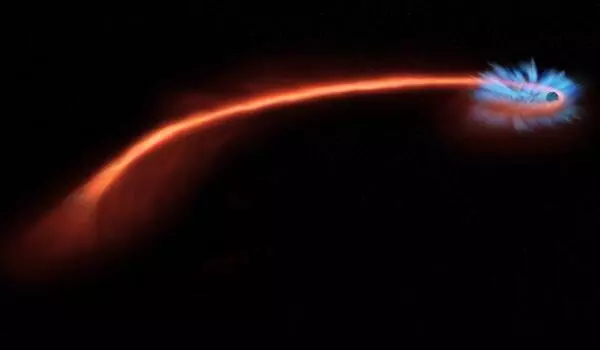Astronomers observed the closest example to date of a star being shredded, or ‘spaghettified,’ after getting too close to a massive black hole in 2019. A sun-like star was tidally disrupted by a black hole 1 million times more massive than itself 215 million light years away. Fortunately, this was the first such event that was bright enough for astronomers to study the optical light from the stellar death, specifically the polarization of the light, to learn more about what happened after the star was ripped apart.
Their observations on Oct. 8, 2019, indicate that a large amount of the star’s material was blown away at high speeds – up to 10,000 kilometers per second – forming a spherical cloud of gas that blocked most of the high-energy emissions produced as the black hole devoured the rest of the star.
Other observations of optical light from the blast, known as AT2019qiz, previously revealed that much of the star’s matter was launched outward in a powerful wind. However, new data on the polarization of the light, which was essentially zero at visible or optical wavelengths when the event was at its brightest, indicates that the cloud was most likely spherically symmetric.
“This is the first time anyone has deduced the shape of the gas cloud around a tidally spaghetiffied star,” said Alex Filippenko, UC Berkeley professor of astronomy and a member of the research team.
The findings support one explanation for why astronomers haven’t seen high-energy radiation like X-rays from many of the dozens of tidal disruption events observed so far: The X-rays produced by material ripped from the star and dragged into an accretion disk around the black hole before falling inward are obscured from view by gas blown outward by the black hole’s powerful winds.
“This observation rules out a class of theoretically proposed solutions and gives us a stronger constraint on what happens to gas around a black hole,” said UC Berkeley graduate student Kishore Patra, lead author of the study. “People have seen other evidence of wind coming out of these events, and I believe this polarization study strengthens that evidence, in the sense that you wouldn’t get a spherical geometry without a sufficient amount of wind. The interesting fact here is that a significant fraction of the material in the star that is spiraling inward is blown away from the black hole rather than falling into it.”
This observation rules out a class of theoretically proposed solutions and gives us a stronger constraint on what happens to gas around a black hole.
Kishore Patra
Polarization reveals symmetry
Many theorists hypothesize that after disruption, the stellar debris forms an eccentric, asymmetric disk, but an eccentric disk is expected to have a relatively high degree of polarization, implying that perhaps several percent of the total light is polarized. This was not the case with this tidal disruption event.
“One of the craziest things a supermassive black hole can do is shred a star with its enormous tidal forces,” said UC Berkeley assistant professor of astronomy Wenbin Lu. “These stellar tidal disruption events are one of the few ways astronomers know about and measure the properties of supermassive black holes at the centers of galaxies. However, due to the high computational cost of numerically simulating such events, astronomers continue to lack understanding of the complex processes that occur after a tidal disruption.”
On November 6, 29 days after the October observation, a second set of observations revealed that the light was very slightly polarized, about 1%, indicating that the cloud had thinned enough to reveal the asymmetric gas structure around the black hole. Both observations were made using the 3-meter Shane telescope at Lick Observatory near San Jose, California, which is equipped with the Kast spectrograph, which can determine light polarization across the entire optical spectrum. When light scatters off electrons in the gas cloud, it becomes polarized (its electrical field vibrates primarily in one direction).

“The accretion disk itself is hot enough to emit most of its light in X-rays,” Patra explained. “However, that light must pass through this cloud, and there are many scatterings, absorptions, and reemissions of light before it can escape. Each of these processes causes some of the light’s photon energy to be lost, all the way down to ultraviolet and optical energies. The photon’s polarization state is then determined by the final scatter. We can therefore deduce the geometry of the surface where the final scatter occurs by measuring polarization.”
Patra noted that this deathbed scenario may apply only to normal tidal disruptions — not “oddballs,” in which relativistic jets of material are expelled out the poles of the black hole. Only more measurements of the polarization of light from these events will answer that question.
“Polarization studies are very challenging, and very few people are well-versed enough in the technique around the world to utilize this,” he said. “So, this is uncharted territory for tidal disruption events.”
Patra, Filippenko, Lu and UC Berkeley researcher Thomas Brink, graduate student Sergiy Vasylyev and postdoctoral fellow Yi Yang reported their observations in a paper that has been accepted for publication in the journal Monthly Notices of the Royal Astronomical Society.
A cloud 100 times larger than Earth’s orbit
The UC Berkeley researchers calculated that the polarized light was emitted from the surface of a spherical cloud with a radius of about 100 astronomical units (au), 100 times farther from the star than Earth is from the sun. An optical glow from hot gas emanated from a region at about 30 au.
The 2019 spectropolarimetric observations were of AT2019qiz, a tidal disruption in a spiral galaxy in the constellation Eridanus. The zero polarization of the entire spectrum in October indicates a spherically symmetric cloud of gas, with all polarized photons balancing one another. The slight polarization of the November measurements indicates a small asymmetry. Because these tidal disruptions occur so far away, in the centers of distant galaxies, they appear as only a point of light, and polarization is one of the few indicators of object shapes.
“These disruption events are so far away that you can’t really resolve them, so you can’t study the geometry of the event or the structure of these explosions,” Filippenko explained. “However, studying polarized light actually helps us deduce some information about the distribution of matter in that explosion or, in this case, how the gas – and possibly the accretion disk – around this black hole is shaped.”














